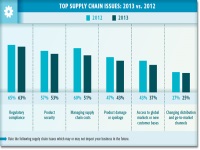Category: “Supply Chain Management”
- Key facts about the 6 largest GPOs
- The Future of Supply Chain: 7 Changes for More Efficient Management
- You are losing business if you don’t have a way of accepting orders electronically?
Hospitals are increasingly looking to electronic processing in their supply chain to achieve cost savings.
- 6 Concerns of Healthcare Supply Chain Executives
1. Regulatory compliance — 63 percent
2. Product security — 53 percent
3. Managing supply chain costs — 51 percent
4. Product damage or spoilage — 43 percent
5. Access to global markets or new customer bases — 37 percent
6. Changing distribution and market channels — 25 percent - Amazon model for supply chain service
"Now a new online direct contracting service called aptitude is attempting a similar coup, letting hospitals and other healthcare organizations negotiate with suppliers in an attempt to speed up the contracting process and reduce costs." The Irving, Texas-based company, which is owned by Novation, one of the nation’s largest group purchasing organizations, brings more transparency to both the buyer and seller, said Kirchenbauer. Aptitude has a database that covers about 40 percent of products bought and sold in U.S. healthcare, so “we are able to tell buyers whether their spend is contemporary with the market … And when they receive a bit back, we can tell them whether that offer is competitive with the kinds of prices that the supplier offers to other customers ….”
- Supply chain’s evolution from the basement to the executive suite
- Supply Chain Software – a great sales opportunity
In fact, supply chain costs are one of the biggest expenses in any hospital's budget. At close to 40 percent of the operating budget for some institutions, the supply chain represents the second largest expense after labor costs. Because the supply chain occupies an outsized space on the balance sheet, implementing more effective inventory management strategies and improving supply chain performance can have a significant impact, with reductions of 10-12 percent possible with even moderate supply chain improvements.
- ACA reshapes the Medical Device Industry – tax benefits drive the business now
"As American hospital operators consolidate, medical-device companies can no longer woo individual doctors over filet mignon, but must present their wares to skeptical, centralized hospital bureaucracies."
- 4 ways to high performing supply chain
- Saving on New Equipment
"Hospital executive teams around the country, in both private and nonprofit organizations, are being challenged by their boards to remove cost from the annual budget."
- 50 things to know about the country’s largest GPOs
- Instant pricing on thousands of medical devices and supplies – Premier GPO releases app
- 2013 The Pain in the Supply Chain
- Customers control pricing now? 135 Hospitals shift major spending on implantables to Abbott and Medtronic
Hospitals and insurers are partnering to reduce prices from manufacturers. This could be a sea change in the current supply change model where customers will dictate price and not suppliers. United Healthcare formed SharedClarity in 2012 with Dignity Health. SharedClarity has expanded to include such prominent IDNs as Advocate Health Care in Illinois and Baylor Scott & White Health in Texas.
- 5 Ways Supply Chain Can Reduce Rising Healthcare Costs


